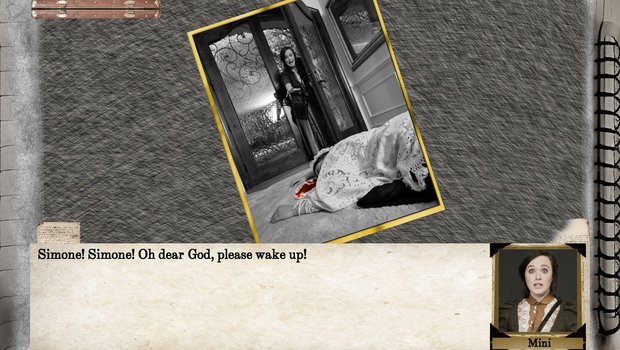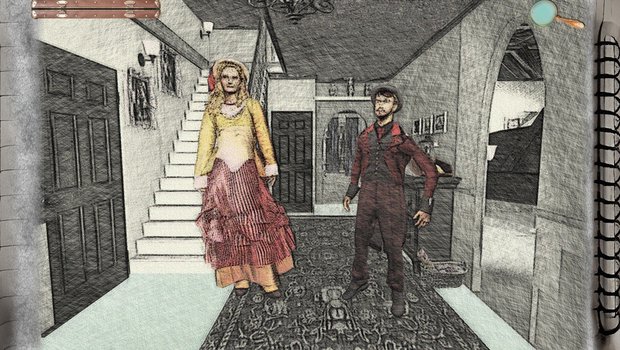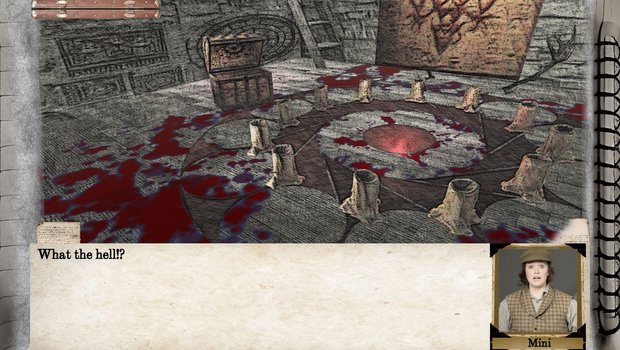Blood on the Thames review

- 1 Comment
An intriguing premise is drowned out by a steady stream of design flaws and technical issues
Playing Blood on the Thames drives home the sobering realization that making games is much harder than we might think. This visual novel pulls inspiration from a wide variety of some of the best-loved games in the genre to spin an (admittedly) intriguing cosmic horror yarn, but in the end falls prey to one simple truth: execution is far more difficult than conception, and even the most promising idea may sound great on paper but lose the devil in its details when it comes to actually gamifying it.
It's the last gasp of the nineteenth century, and Minerva “Mini” Ernest is having a rough go of it. Her husband Quincy, one of London’s wealthiest shipping magnates, has just died under suspicious circumstances, drowning in the Thames late one night, his body later found covered in odd cuts and wounds. While this inciting incident occurs before the game officially starts, and we technically won’t meet Mini until its second chapter, this mysterious death soon kicks off a rather wild and unpredictable Lovecraftian horror story as further bodies with similar wounds begin to pile up, oddly spaced apart every 28 days. Soon it’s up to Mini and a group of friends and associates she meets along the way to investigate these grisly murders, infiltrate a local cult, defend themselves against vicious blood beasts, do some light time traveling, and even – why not? – solve the mystery of Jack the Ripper to boot.
It's quite an intriguing list of bullet points, and it certainly sounds like a blast. And the premise is indeed notable, with a worthy story at the heart of it all. Characters are provided with depth and quirks, with some genuinely charming interactions and relationships in store as the narrative unfolds. But all that is quickly overshadowed by problems as Blood on the Thames branches out in various directions in an attempt to turn an appealing elevator pitch into an entertaining game. From the presentation to the puzzles, from the user interface to the game’s coding – virtually every aspect of the game falls short of its potential, resulting in an ever-dwindling amount of enthusiasm each time I sat down for another go at its considerable twenty-hour runtime.

Let’s start with the visual novel narrative we’ll spend most of our time with. The text box takes up perhaps the bottom third of the screen during normal gameplay, which is where all exposition and character interactions play out. It’s worth noting that the amount of text is sometimes a little overwhelming, and rather than break it up into more manageable chunks to advance through, there are times when the entire text box is stuffed end-to-end. In fact, occasionally there is more text than can fit in the box, and with no way to scroll down, the final bits end up being cut off mid-sentence (though at least there’s a text log you can check if that happens). When Mini goes to bed, we experience her dreams as the whole screen turns black and fills with further walls of green text.
The amount of reading isn’t a huge issue on its own; after all, visual novels aren’t known for their brevity. Where Blood on the Thames struggles is in the quality of the writing, both in terms of language use and content. Spelling and grammatical errors are commonplace, from incorrect or missing punctuation to capitalization issues and the occasional funky sentence structure. If poor usage of writing conventions is your pet peeve, you will regularly find your nerves poked and prodded. At first I thought this might simply be due to a language barrier, but entire sections (Mini’s dreams, in particular) show off a defter understanding, with complex sentence structures and precisely detailed descriptions. Instead, I suspect that different writers were responsible for specific areas, which would account for changes in style and composition. Regardless, the whole endeavor is badly in need of an editor’s guiding influence, if for no other reason than to cut down on the amount of repetition or lengthy scenes overstaying their welcome for the sake of needless minutiae.
Unlike in most visual novels, here we also get to see the story acted out for us. The designers have hired a crew of actors to portray the game’s characters in still photos as we read about their exploits. The screen will cycle through a slideshow to accompany the text, featuring fully costumed characters (sometimes dressed in noticeably ill-fitting get-ups) against digital backgrounds, except for the more mundane settings, like Mini’s parlor, which seem to use real locations. While the game doesn’t reach for anything as grandiose as full-motion video, it looks like the actors were enjoying themselves, and having real performers helps a great deal in cementing the story and characters in your mind, some of whom kind of grew on me the further I went along.

When not stuck in a visual novel portion – so anytime we’re navigating the streets of London or when characters move about – we’re subjected to dealing with the in-engine graphics. These sections are displayed in first-person perspective (Mini does appear, but only in the photo slideshows during the visual novel bits). Stylistically, a comparison that comes to mind is the 2007 Nintendo DS classic Hotel Dusk: Room 215, which utilized a similar pencil-and-sketchpad look that Blood on the Thames seems to be going for. Only here, everything is presented almost entirely in monochrome, really just offering various shades of gray, with very limited pops of color (that are so random as to be quite ineffective). And while the hatch-marked sketch aesthetic is present and accounted for, it’s utterly devoid of fine detail. Apart from the general ugliness of it all, the lack of identifiable features to set apart objects in the environment creates a fair amount of guesswork when it comes to general interactions and even solving puzzles.
Worse, the cast of characters we’ve gotten to know via their photo slideshows are replaced here by bone-chillingly ugly impostors that often don’t resemble their real-life counterparts at all, instead featuring off-putting and unnatural animations and proportions. One character in particular appears to have an extra pair of elbows hidden in the sleeves of his lapel jacket – watching him dance around or play the piano is akin to a scene from a childhood nightmare. I’m by no means a graphics snob, but what we’re forced to endure here can only be described as hideous, and is far more horrifying than any Lovecraftian elements the game can cook up.

While looking at the game can be unpleasant enough, actually having to play any of it when it breaks away from its visual novel roots is far worse. I’d love to give credit where credit is due by praising the inclusion of a number of puzzles to solve, but, once again, it’s all in the execution, which is, also once again, subpar at best. The cynic within me would say that the designers knew what they had on their hands here, which is why they – mercifully – decided to include an option to skip each puzzle immediately and without penalty. For the sake of review, I’ll pretend I never made use of this Get-Out-of-Jail-Free card and talk about how it all works (or doesn’t).
Puzzles switch to a full-screen perspective, are operated by pointing and clicking, and range from rotating rings into position to unlock a secret door to piling up pieces of coiled rope by size. While these are two of the more pedestrian examples, they work fine as mental palate cleansers. Others, however, show the designers stretching their creative muscle a bit more. A rather interesting one revolves around matching newspaper clippings with a lunar calendar to create a timeline of events surrounding the murders. Another far more esoteric example had me comparing various river current charts of the Thames and cross-referencing them with a tidal almanac. It’s nice that some of these puzzles went out of their way to fit with the game’s setting and narrative, but I struggle to call any of them actually fun or satisfying.
There is yet another major puzzle type I need to mention here. Taking inspiration from Ace Attorney-style courtroom dramas, each of the game’s eleven chapters culminates in a timed interrogation scene where your job is to question a character and prove that they are lying to you. You’re given fifteen minutes (shown via a constantly ticking on-screen timer) in order to refute the witness’s statements one by one, including one final fill-in-the-blank conclusion. You need to finish all this successfully before the timer runs out or it’s game over (though you can restart the game just prior to an interrogation). To refute a statement, you’ll need to select both the specific statement that is faulty and present a piece of evidence that contradicts it. Get either of these two things wrong and the game shaves thirty seconds off your time, every time.
While that doesn’t sound too bad – after all, this style of puzzle is pretty common these days – its implementation feels clunky here. This is partly due to the number of potential choices you can present as evidence, with the list continually growing as the game goes on since it’s never purged. Then there’s the fact that either the subject’s statements or your evidence against them can be difficult to interpret. Choosing the correct item may trigger a dialog exchange that’s only tangentially related, at best, making it an act of luck if you can correctly intuit where the game wanted to steer the next bit of narrative. Or you may have multiple pieces of evidence seemingly all saying the same thing, but the game will only accept a specific one as correct.

Finally, there are times when it’s actually easy to pinpoint the faulty statement immediately, but the sentence in question may be broken down into multiple parts to select from. If a suspect mentions walking by the Thames at midnight, you may have to decide whether you’ll want to question the time, the place, or the manner of ambulation specifically. Get any one of them wrong and it’s half a minute off your time before you can try again for another combination or pursue a wholly different tack. Further aggravating things is the fact that these interrogation scenes have even more dialogue interspersed throughout, which you’ll need to read while the timer keeps ticking. Getting most of the way through an interrogation only to get timed out at the end while reading a lengthy exchange is very frustrating. The best course of action is to resign yourself to failing each interrogation at least once or twice so you can read all necessary banter, then reload from a well-placed checkpoint and fast-forward through all the text on your next try.
Musically the game is a mixed bag as well, including some compositions that I almost hesitate to call songs since they more closely resemble random notes strung together. But other pieces are decent enough, even if they are inoffensive at best. During a light-hearted moment of comedic relief, for example, a jaunty, silly track may accompany the on-screen shenanigans, while preparing to climb into a dark cellar to stare down a vicious blood beast will be set to a more suspenseful piece. None of the tracks were catchy enough to worm their way into my ear, and in some scenes the music becomes oddly toned down – still present somewhere in the background, but so subdued that it may as well have been completely silent. Voice acting is also entirely absent, though with the amount of dialogue involved, that may be preferable.
Even with all these red flags, Blood on the Thames may so far come across as pretty middle-of-the-road. Sure, the art can be an eyesore, the writing is hit-or-miss, music is nothing to write home about, and the puzzles won’t appeal to everyone but at least come with a handy skip feature. Sadly, the final – and worst – nail in the game’s coffin is its extremely buggy performance. I played it across many different sessions, and I can’t remember a single one where some technical issue didn’t rear its ugly head. We’re not talking the occasional small hiccup either (okay, we’re talking those too) but full-on, progress-halting digital seizures that required replaying sections or entire chapters, more than enough reason for any reasonable person to assume their playthrough was completely borked.
For point-and-click gameplay, I would call being able to find and activate hotspots pretty vital. Sure, the game does have a hotspot finder that shows clickable areas of interest and exits to other screens. The trouble is, these hotspots don’t always remain in working order. For instance, I found myself trapped in Mini’s upstairs hallways a few times because the “go downstairs” hotspot simply wouldn’t activate when clicked. Worse than a malfunctioning hotspot, though, is when crucial parts of a scene simply stop existing. On at least three occasions in three separate chapters, I was at the game’s mercy when a character required to complete a puzzle simply wouldn’t load into the scene. Elsewhere, three chapter restarts were needed to move on: a first when the character initially went missing, a second when said character returned but the puzzle refused to initiate, and a third when everything finally worked as intended.
Disappearing and malfunctioning game elements are kind of the rule rather than the exception, and it seemed the longer the software was running the worse the performance got. One whole inventory screen became routinely blocked off during interrogations, and text would fill in vertically, like
t
h
i
s,
making it unreadable. Disappearing characters, hotspots that fail to display text when clicked on, booting up only to a black screen on which nothing can be done except to restart the game and hope to have better luck, harsh sound effects looping on and on even after their scene has ended, lack of a manual save option routinely causing up to half an hour’s worth of lost progress – the list goes on and on.
Final Verdict
It all adds up to a game that is nearly impossible to recommend. While the narrative does have some redeeming qualities, like an intriguing premise and some genuinely warm character interactions, it would take a special kind of patience to look past all the shortcomings in Blood on the Thames and find something worth the time and effort it takes to play. Bad enough that there are many issues present that, individually, would be hard to swallow, but the sheer buffet of questionable design choices on offer here make for a meal that’s, sadly, wholly unpalatable.
Hot take
Wasting a promising idea, Blood on the Thames is so bug-riddled and poorly executed that the actors working on it were clearly having more fun than you ever will.
Pros
- Intriguing premise about a Lovecraftian blood cult haunting the streets of Victorian London
- Some charming writing makes a few characters endearing
Cons
- Character models, and in-engine graphics in general, are U-G-L-Y
- Puzzles are either unclear, unfun, unnecessary, or a combination thereof
- Timed interrogation sections seem designed to fail at least a couple of times
- Lots of text, littered with nearly as many errors
- Bugs both great and small infest the experience from beginning to end
Pascal played Blood on the Thames on PC using a review code provided by the game's publisher.











1 Comment
Want to join the discussion? Leave a comment as guest, sign in or register in our forums.
Totally understand. I played the demo and didn't even finish THAT.
Reply
Leave a comment